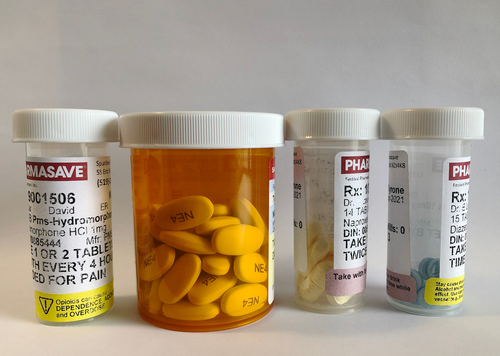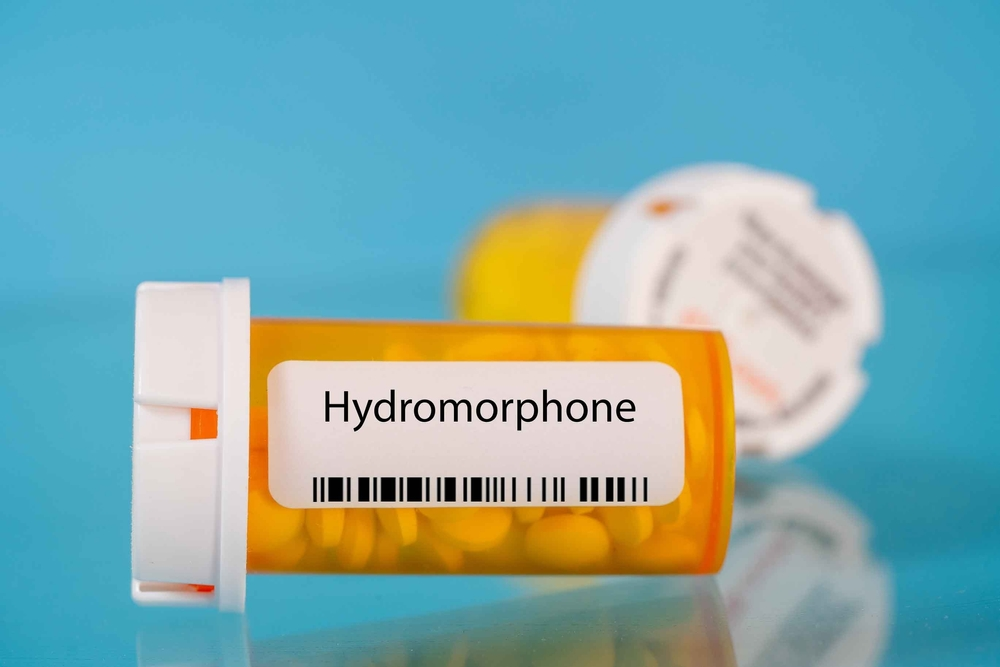Dilaudid is an opioid analgesic* drug known for its potent pain-relieving properties. It is commonly prescribed in tablet or oral solution form to individuals experiencing moderate to severe pain.
Due to its high potential for abuse and addiction, we wrote this blog so you can understand how long Dilaudid stays in your system, how it can be detected, and if it’s addictive.
Dilaudid can stay in your system anywhere from 15 hours to four days after you take it, with some versions of the drug hitting their peak around 15 minutes.
What Is Dilaudid?
Dilaudid, also known as hydromorphone hydrochloride, is a Schedule II opioid prescribed to temporarily relieve severe or chronic pain. Dilaudid operates by altering certain chemicals, including dopamine and serotonin, within the brain. This blocks pain signals and induces a sense of well-being or euphoria.
Opioids and painkillers impact the brain’s reward system by increasing dopamine production, a neurotransmitter that influences mood and generates feelings of contentment. This surge in dopamine levels, similar to pleasurable activities such as eating or engaging in sexual activities, can be experienced when taking high doses of Dilaudid and other opioids. The brain develops a natural inclination to seek the repetition of this pleasurable process, contributing to the addictive nature of hydromorphone. Continued misuse of hydromorphone fosters a pattern of drug abuse, ultimately leading to physical dependence.

How Long Does Dilaudid Stay In Your System After You Take It?
How long Dilaudid stays in your system depends on the specific form of the drug. Hydromorphone, the parent drug of Dilaudid, is available in different dosage forms, some of which have a rapid onset of action and provide immediate relief. These fast-acting forms typically have shorter-lasting effects. It is worth mentioning that not all of these forms are marketed as Dilaudid, but they all contain the same drug.
Quick-Acting Oral Liquid: This version of Dilaudid reaches your bloodstream between 30–60 minutes.
Quick-Acting Oral Tablet: This version takes 30–60 minutes to reach your bloodstream.
Quick-Acting Injection: Injecting Dilaudid has the quickest effect time at about 15 minutes and can last more than 5 hours.
Quick-Acting Suppository: This version is longer acting than other forms of Dilaudid and can last around 8 hours.
Long-Acting Oral Tablet: An oral tablet can take around 8 hours to kick in, with most of the drug reaching your bloodstream in 16 hours. This long-acting version of Dilaudid can last around 24 hours before its effects taper.
What Is The Half-Life Of Dilaudid?
The half-life of Dilaudid (the time it takes for half of the drug to leave your system) depends on the specific form of the drug being taken. Here are the average half-lives for each dosage form:
Quick-Acting Oral Liquid: A little under 3 hours.
Quick-Acting Oral Tablet: About 2.3 hours.
Quick-Acting Injection: A little less than 2.5 hours.
Long-Acting Oral Tablet: Usually around 11 hours.
The half-life of Dilaudid is influenced by the bodily fluid in which it is detected. In the case of blood, the half-life of the fast-acting drug can range from 2.5 to 4 hours. In saliva, the half-life of the fast-acting form is slightly over two hours.

How Long Can Dilaudid Be Detected In Drug Tests?
The detection period of Dilaudid depends on the drug test.
Urine: Dilaudid can be detected in urine tests within two to four days after use. However, if only a single dose of Dilaudid has been taken, it may only be detectable in urine for about 11 to 24 hours after use.
Blood: Recent advancements in technology have shown Dilaudid to be detectable in the blood for up to 10 hours to two days after use.
Saliva: Dilaudid is quickly detectable in saliva, particularly when administered through injection. Traces of the drug can typically be found in saliva between six hours to four days after use.
Hair: Hair tests can detect Dilaudid within 90 days after the last use.
Factors That Change Detection Time
Here are some factors that can alter or affect how long Dilaudid stays in your system.
Amount Used: When a larger quantity of Dilaudid is consumed, it increases the workload for the liver to eliminate the drug, resulting in a longer duration of the drug’s presence in the system.
Frequency of Use: Regular and frequent use of Dilaudid can lead to an extended duration of the drug remaining in the body. This is because the drug accumulates in the system over time.
Method of Use: Short-acting forms of Dilaudid typically exit the body more rapidly than longer-acting forms of the drug.
Age: Older individuals, especially those with kidney problems, may experience difficulties in eliminating Dilaudid from their system.
Overall Health: Generally, individuals in better overall health tend to clear Dilaudid from their system faster than those in poorer health.
Urine pH: The acidity or alkalinity of urine, known as urine pH, can affect the elimination of certain drugs, including Dilaudid.
Hydration: Proper hydration is important for drug elimination. When the body is well-hydrated, urine production increases, aiding in the excretion of Dilaudid and its metabolites. On the other hand, dehydration can result in concentrated urine and potentially slow the elimination process.

False Positives for Dilaudid
Various substances can potentially interfere with or cause false positives in tests designed to detect other opioids or related compounds. These include:
- Poppy seeds
- Antibiotics like rifampin, rifampicin, levofloxacin, and ciprofloxacin
- Naloxone
- Suboxone and Subutex
- Morphine
Is Dilaudid Addictive?
Because Dilaudid targets pain receptors, it can become addictive to individuals who initially used the drug to cope with an injury or post-surgery recovery. Once the injury is healed, some people may have leftover Dilaudid in their medicine cabinet, taking it to experience the same euphoric effects. Abusing hydromorphone over an extended period can lead to addiction, and physical dependence can develop in as little as a few weeks.
Additionally, specific patterns of abuse amplify the risk of overdose. For example, taking higher-than-prescribed doses or combining it with other medications or alcohol can result in an overdose. Accidental opioid overdose can also occur if an extended-release formulation is taken more frequently in a day than prescribed. Symptoms of a Dilaudid overdose include:
- Blue skin, fingernails, or lips
- Extreme sedation
- Sleepiness
- Limp or weak muscles
- Slowed, stopped, or difficulty breathing
- Loss of consciousness or coma
- Slow or stopped heartbeat
- Dizziness
- Fainting
- Dilated pupils
- Difficulty concentrating
- Cold, clammy skin
Can An Addiction To Dilaudid Be Treated?
Yes, an addiction to Dilaudid can be treated. Recognizing and addressing addiction to this powerful opioid is the first step to reclaiming one’s health and well-being. Detoxification, or detox, plays a crucial role in the treatment process. This involves the supervised withdrawal of Dilaudid from the body, allowing it to eliminate the drug and stabilize without experiencing severe withdrawal symptoms like nausea, anxiety, sweating, and loss of appetite.
Detox isn’t the only thing you need to do to recover. Still, it sets the foundation for comprehensive addiction treatment programs, which may include therapy, counseling, support groups, and other interventions tailored to individual needs. These comprehensive approaches address the psychological, emotional, and behavioral aspects of substance abuse, providing individuals with the tools and support necessary to overcome their addiction to Dilaudid and maintain lasting recovery.

Contact MD Home Detox
If you or someone you know is struggling with an addiction to Dilaudid or other prescription drugs, contact MD Home Detox. Our at-home detox kits and home visits can help you process the withdrawal symptoms of Dilaudid. But our care doesn’t stop there. We can point you toward an addiction treatment program where you can overcome the underlying issues behind Dilaudid abuse, including trauma, depression, and anxiety.

